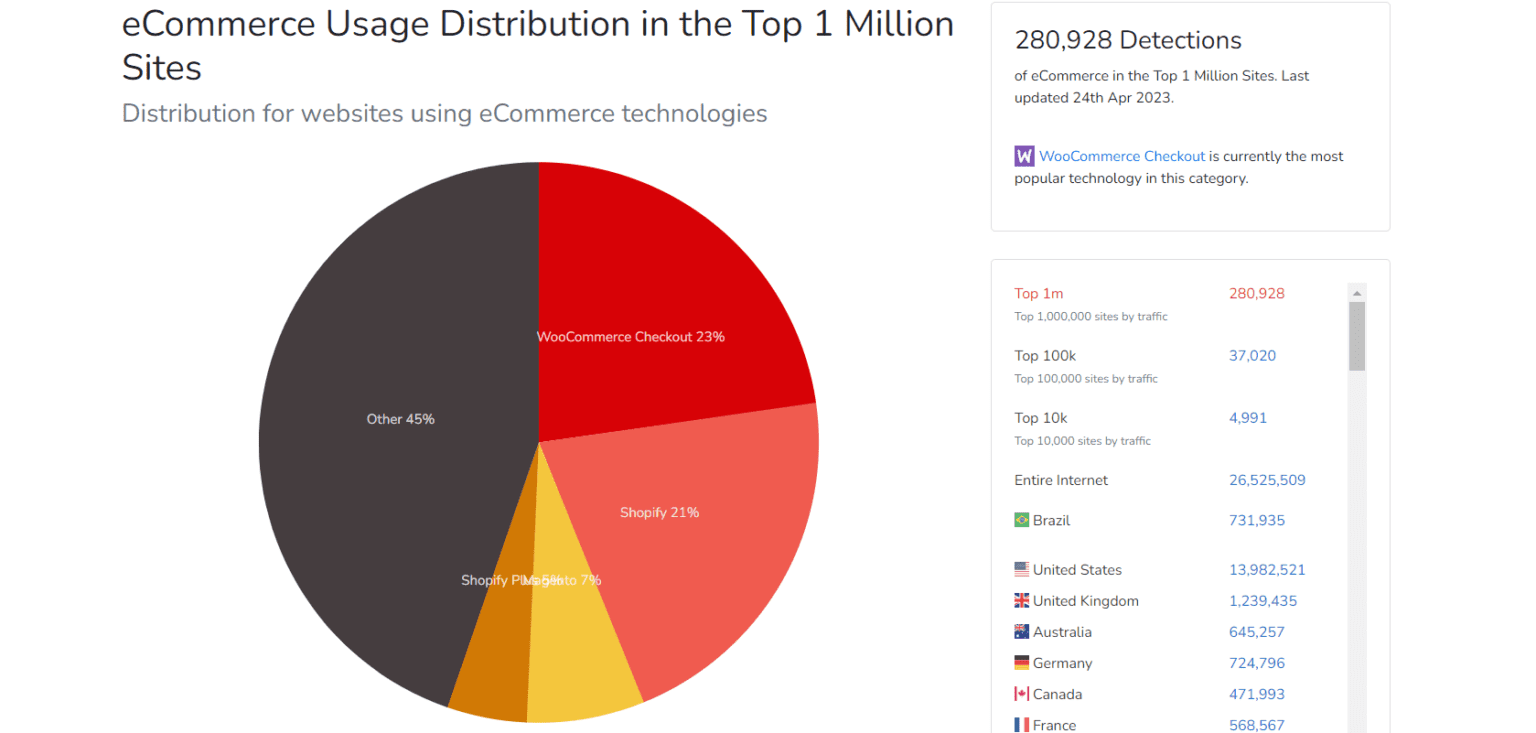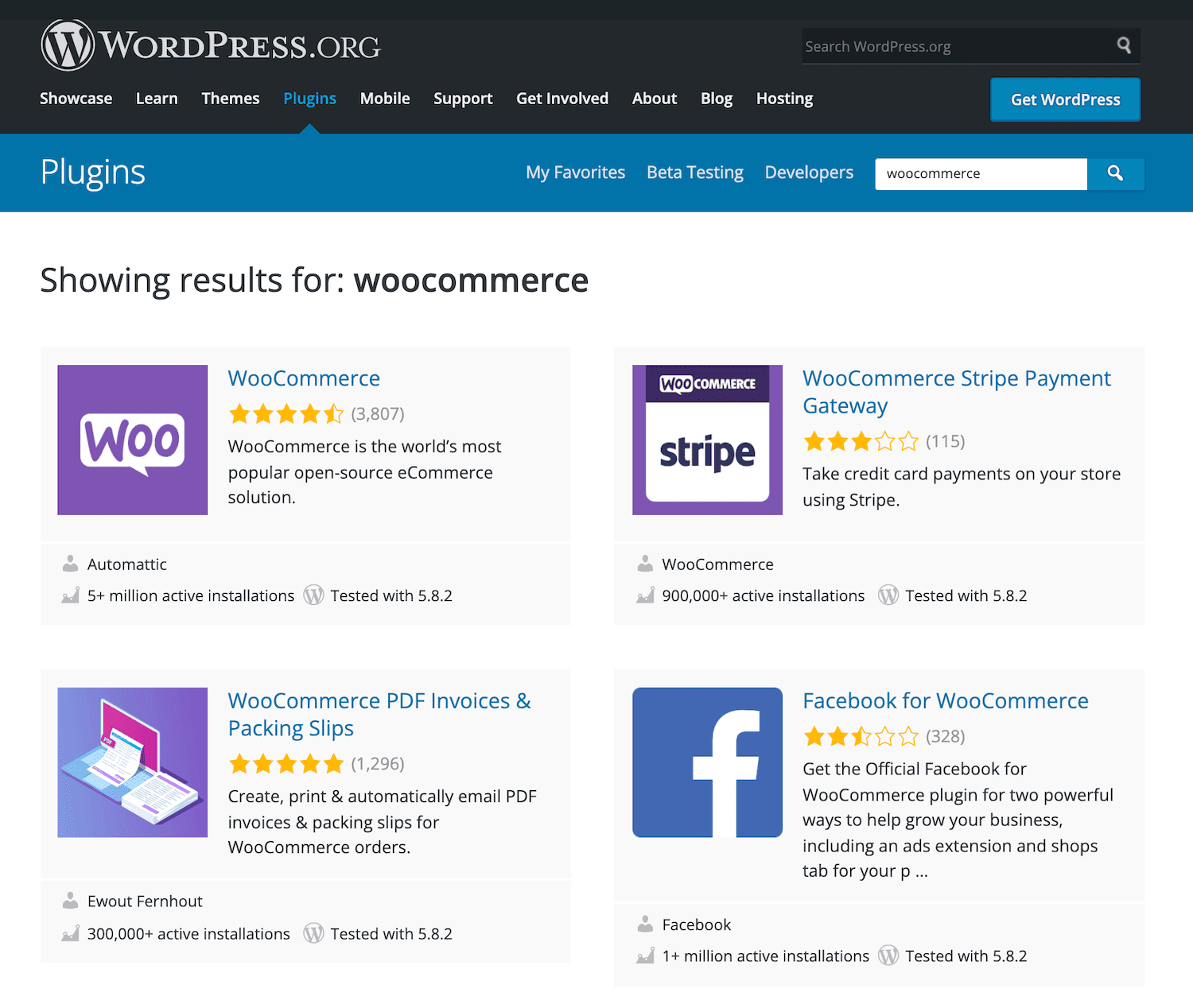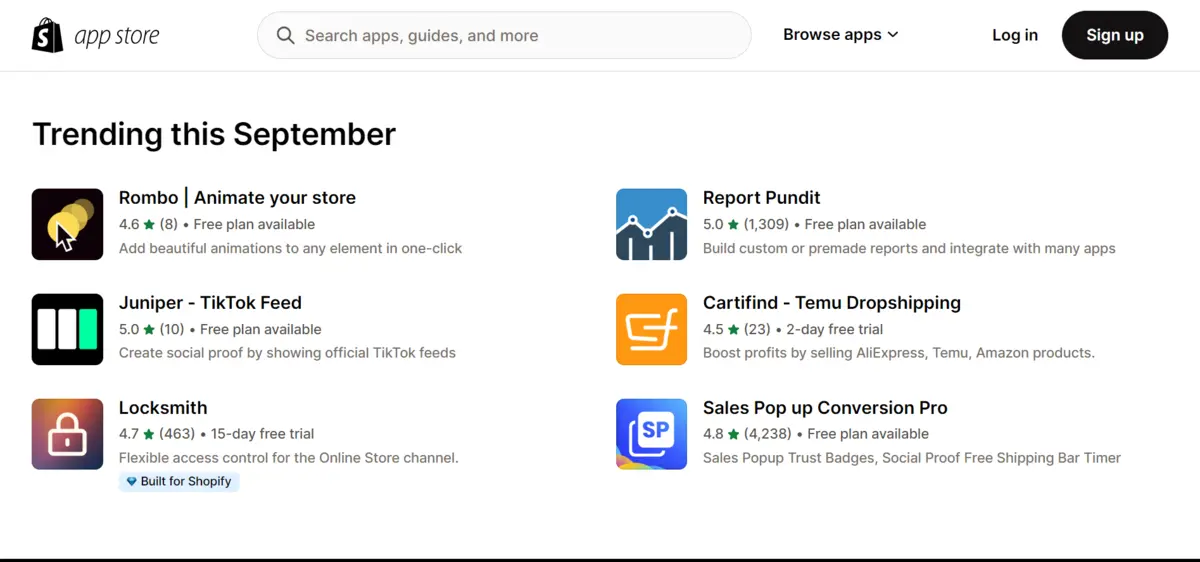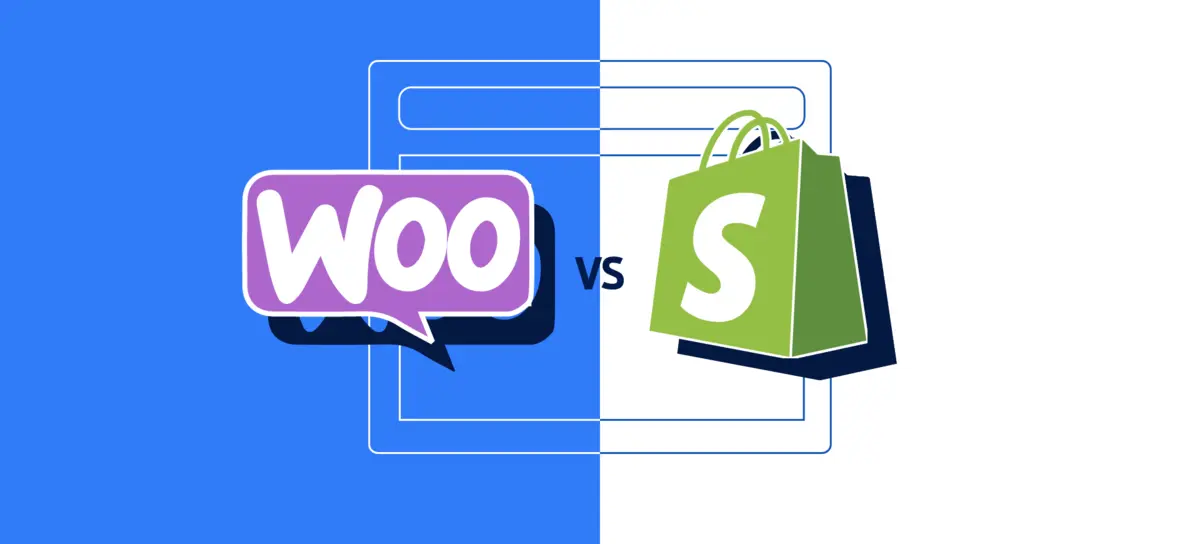WooCommerce vs Shopify: Choosing the Right Platform – With global ecommerce sales reaching $5,7 trillion, there has never been a better opportunity to establish an online store.
However, selecting the optimal ecommerce platform between WooCommerce and Shopify is not always simple.
In order to compare these two prominent ecommerce platforms, we’ve created this WooCommerce vs. Shopify guide. Nevertheless, there are notable differences between them.
Summary of Key Points
HideThis article will help you determine whether WooCommerce or Shopify is the ideal ecommerce platform for your business.
We’ll discuss the usability of these platforms, as well as their features and all-important pricing.
WooCommerce vs Shopify: A Comprehensive Comparison
| Feature/Criteria | WooCommerce | Shopify |
|---|---|---|
| Pricing | Free plugin, costs vary based on hosting, themes, and plugins | Subscription-based, starting at $29/month |
| Ease of Use | Steeper learning curve, more complex setup | User-friendly, easier for beginners |
| Customization | Highly customizable, open-source | Limited customization, closed platform |
| Transaction Fees | No additional transaction fees | Transaction fees for third-party payment gateways |
| Hosting | Self-hosted, choice of hosting provider | Hosted solution, managed by Shopify |
| Security | User-managed, requires SSL and other security measures | PCI compliant, SSL included, managed security |
| Scalability | High, dependent on hosting and technical management | High, managed scalability |
| Support | Community support, no official support for the free plugin | 24/7 official customer support |
| Dropshipping | Requires additional plugins | Built-in support with apps like Oberlo |
In the rapidly evolving world of eCommerce, the platform you choose can make or break your online business.
The right platform not only simplifies the management of your online store but also provides the tools you need to grow and scale.
Two giants in this space, WooCommerce and Shopify, often find themselves pitted against each other in the debate over the best eCommerce solution.
This article aims to offer a balanced and in-depth comparison of WooCommerce vs Shopify, helping you make an informed decision tailored to your business needs.
Platform Overview
Both WooCommerce and Shopify have so many features which will depend on the users need, things to sell, advantages and disadvantages. But before getting there, first let’s start knowing them both deeper.
What is WooCommerce?

WooCommerce is an open-source eCommerce plugin designed for WordPress, one of the most popular content management systems in the world.
Being open-source means that the software is free to use, modify, and distribute.
However, this freedom comes with its own set of challenges, including the need for some technical know-how and the responsibility of hosting your own website.
WooCommerce offers a high level of customization, allowing you to tweak every aspect of your online store.
From the look and feel of your website to the user experience, everything can be customized to fit your brand’s unique identity.
This makes WooCommerce a popular choice for businesses that require a highly personalized online store.
What is Shopify?


On the other end of the spectrum, Shopify is a standalone eCommerce platform that offers a more streamlined, out-of-the-box solution. Unlike WooCommerce, Shopify is not a free platform.
It operates on a subscription model, with monthly fees that can range from $39 to $399, depending on the plan you choose.
Shopify is known for its user-friendly interface, making it easy for even those with limited technical skills to set up and run an online store.
The platform offers a range of built-in features, including payment gateways, inventory management, and basic SEO capabilities.
However, this ease of use comes at the cost of limited customization options, especially when compared to WooCommerce.
We previously have crafted a comprehensive article about what is Shopify and how does it work. You might want to read it first.
Also read our comprehensive Shopify tutorial and detailed guide on how to use Shopify.
In the next section, we’ll delve deeper into the features offered by both platforms, providing a side-by-side comparison to help you understand the strengths and weaknesses of WooCommerce vs Shopify.
Shopify vs WooCommerce: Features Comparison
Navigating the feature sets of WooCommerce and Shopify can be a complex task. Both platforms offer a robust range of functionalities designed to facilitate various aspects of eCommerce.
However, the way these features are implemented and their ease of use can differ significantly.
In this section, we’ll dissect the key features of each platform, offering insights into how they stack up against each other.
Product Management
Managing products is a cornerstone of any eCommerce platform.
The ease with which you can add, modify, and manage your product listings directly impacts your store’s efficiency and your customer’s experience.
Let’s see how WooCommerce and Shopify fare in this critical area.
WooCommerce
WooCommerce leverages the power of the WordPress editor, also known as the Gutenberg editor, to manage products.
This editor allows you to add detailed product descriptions, images, and other media.
You can also categorize products, set prices, and manage stock levels with ease.
The platform’s open-source nature means you can extend its capabilities through plugins, offering functionalities like product variations, custom attributes, and more.
Shopify
Shopify offers a straightforward product management system that somewhat resembles the WordPress editor. You can add product details, images, and set prices without much hassle.
Shopify also provides options for product variations, but unlike WooCommerce, the customization capabilities are somewhat limited.
However, Shopify does offer built-in features like abandoned cart recovery, something you’d need a plugin for in WooCommerce.
Payment Gateways
Payment gateways are another critical aspect of eCommerce platforms.
The variety and flexibility of payment options can significantly influence customer satisfaction and conversion rates.
Here’s how WooCommerce and Shopify compare in terms of payment gateways.
WooCommerce
WooCommerce provides a plethora of WooCommerce payment gateway options, including PayPal, Stripe, and various other local and international payment methods.
One of the standout features is that WooCommerce does not charge any additional transaction fees, regardless of the payment gateway you choose.
This can be a significant advantage for store owners looking to minimize costs.
Shopify
Shopify, on the other hand, encourages the use of its own payment solution, Shopify Payments. While it does support third-party payment gateways, using them incurs additional transaction fees.
These fees are over and above the charges levied by the payment gateway itself, making Shopify potentially more expensive in this regard.
In the following sections, we’ll explore other critical aspects like pricing, ease of use, and customization capabilities.
These factors play a crucial role in the ongoing debate of WooCommerce vs Shopify, and understanding them can help you make a more informed decision for your online store.
Comparing WooCommerce vs Shopify: What is the Market Share of Each?
Shopify and WooCommerce are two of the world’s most popular ecommerce platforms. While it is unwise to choose a solution solely based on its prevalence, it is interesting to compare the number of users on each platform.
Around 21 percent of the top one million ecommerce websites use the Shopify platform. In comparison, 23% of these leading websites rely on WooCommerce to operate their online store.
WooCommerce may be marginally more popular on websites with greater authority. However, there is still a great deal of growth potential for both of these platforms in the enterprise market:


Beyond the enterprise market, WooCommerce is significantly more prevalent. It is utilized on over six million active websites, whereas Shopify operates over four million active websites.
Shopify has consistently attracted more search interest than WooCommerce over the past five years, according to Google Trends data.
Google Trends Graph for WooCommerce vs Shopify
While Shopify is a standalone solution, WooCommerce is inextricably linked to the world’s most popular CMS. In fact, over 40% of all websites use WordPress, and 7% of all ecommerce websites use WooCommerce.
These statistics significantly contribute to WooCommerce’s popularity. If you are one of the millions of individuals who already have a WordPress website, WooCommerce becomes immediately more appealing.
Comparing the Pricing of Both Platforms
When it comes to running an online store, costs are a significant consideration. Both WooCommerce and Shopify have their own pricing models, each with its own set of advantages and disadvantages.
Understanding these can help you budget effectively and choose the platform that offers the best value for your specific needs.
WooCommerce
WooCommerce is technically a free plugin, but the overall cost of running a WooCommerce store can vary widely.
This is because you’ll need to account for additional expenses like web hosting, SSL certificates, and any premium themes or plugins you might want to use.
One of the key advantages of WooCommerce is that it doesn’t charge any transaction fees, which can result in significant savings as your store grows.
Costs to Consider
- Hosting: Ranges from $5 to $100+ per month, depending on the provider and plan.
- Themes and Plugins: Free options are available, but premium themes can cost around $50 to $200, and plugins can range from $15 to $100+.
- SSL Certificate: Usually around $70 per year, although some hosting providers offer it for free.
Shopify
Shopify operates on a subscription-based model, offering various plans that range from $39 to $399 per month. Each plan comes with its own set of features and limitations.
Unlike WooCommerce, Shopify charges transaction fees if you choose to use a third-party payment gateway instead of Shopify Payments. These fees can add up, especially for stores with high sales volumes.
Costs to Consider
- Monthly Subscription: Basic Shopify ($39/month), Shopify ($105/month), and Advanced Shopify ($399/month)
- Transaction Fees: Vary depending on the plan and the payment gateway used.
- Additional Features: Some features, like advanced reporting and third-party integrations, may require additional fees.
The complete pricing plan is as follows:
| Basic Shopify $39/month | Shopify $105/month | Advanced Shopify $399/month | |
| Transaction Fees*if not using Shopify Payments | 2.9% + 30¢ online2.7% + 0¢ offline | 2.6% + 30¢ online2.5% + 0¢ offline | 2.4% + 30¢ online2.4% + 0¢ offline |
| Staff Accounts*assign & manage staff’s activities | up to 2 | up to 5 | up to 15 |
| Report Systems | Basic reports | Professional reports | Custom reports |
| Workflow Automation*automatically manage & operate stores | — | fully supported | fully supported |
| Inventory Locations*more locations to track stocks & fulfill orders | 4 | 5 | 8 |
| Shipping Discount*shipping subsidies with leading carriers | up to 77% | up to 88% | up to 88% |
| Duties and import taxes | — | — | fully supported |
| Third-party calculated shipping rates | — | — | fully supported |
In the next section, we’ll delve into the ease of use for both platforms. This is a crucial factor, especially for those who may not have extensive technical skills.
The user experience can significantly impact how quickly you can set up your store and start selling, making it a key point in the WooCommerce vs Shopify debate.
Comparing the Ease of Use
The user experience is a pivotal factor in the success of any eCommerce platform.
A platform that’s easy to navigate can save you time and reduce the learning curve, allowing you to focus more on growing your business.
In this section, we’ll examine how user-friendly WooCommerce and Shopify are, especially for those who may not have a technical background.
WooCommerce
WooCommerce is a powerful platform, but its ease of use can be a double-edged sword. On one hand, the extensive customization options offer you unparalleled control over your online store.
On the other hand, this flexibility comes at the cost of complexity.
Setting up a WooCommerce store involves multiple steps, including installing WordPress, the WooCommerce plugin, and additional extensions for added functionalities.
While the platform offers detailed documentation and tutorials, some level of technical expertise is beneficial for navigating the setup process and ongoing management.
Key Points to Consider
- Learning Curve: Steeper compared to Shopify, especially for those new to WordPress.
- Customization: Offers more control but can be overwhelming for beginners.
- Documentation: Extensive guides and tutorials are available, but some technical knowledge is beneficial.
Shopify
Shopify is designed with ease of use in mind. The platform offers a more streamlined setup process, guided by a user-friendly interface.
Even if you’re new to eCommerce, you can set up a Shopify store relatively quickly without needing to delve into code or technical settings.
The platform also offers 24/7 customer support, providing an additional safety net for users who may encounter issues or have questions.
Key Points to Consider
- Learning Curve: Generally easier for beginners to get started.
- Customization: Limited compared to WooCommerce, but sufficient for most standard eCommerce needs.
- Customer Support: 24/7 support provides a safety net for new and existing store owners. Shopify tutorial is also available anywhere on the official site.
In the upcoming sections, we’ll explore customization and flexibility, another critical aspect that differentiates WooCommerce and Shopify.
Your ability to tailor the store to meet your specific needs can significantly impact your store’s success, making it a crucial factor in the WooCommerce vs Shopify comparison.
Customization and Flexibility Aspects: Which One is Better?
The ability to tailor your online store to meet specific business needs and customer expectations is a crucial factor in choosing an eCommerce platform.
Customization and flexibility can affect everything from the user experience to SEO. In this section, we’ll explore how WooCommerce and Shopify compare in terms of customization capabilities and flexibility.
WooCommerce


WooCommerce excels in customization and flexibility, thanks to its open-source nature.
You have complete control over the code, allowing you to modify every aspect of your store, from the frontend design to the backend functionalities.
This level of control is particularly beneficial for businesses with unique requirements that can’t be met by out-of-the-box solutions.
However, this flexibility comes with a caveat: you’ll need some technical skills to make the most of it.
Key Points to Consider
- Themes and Plugins: A wide variety of themes and plugins are available to extend the functionality of your store.
- Code Access: Complete access to the code allows for extensive customization, but requires technical expertise.
- Community Support: A large community of developers and users can provide solutions and customizations, although this isn’t a substitute for official support.
Shopify


Shopify offers a more constrained environment for customization. While it does provide a range of themes and built-in features, you’re limited by what Shopify allows you to do within its platform.
For advanced customizations, you may need to rely on third-party apps or seek professional help, which can add to the costs.
However, the limitations in customization are often offset by the platform’s ease of use and customer support.
Key Points to Consider
- Themes and Apps: Shopify offers a range of professionally designed themes and apps, but these come with their own costs.
- Limited Code Access: Shopify does allow some level of code customization through its Liquid templating language, but it’s not as extensive as WooCommerce.
- Customer Support: 24/7 customer support can assist with minor customizations and troubleshooting.
In the next section, we’ll delve into the scalability of both platforms. As your business grows, your platform needs to grow with it.
The ease with which you can scale your business operations can have a long-term impact on your business, making it a vital aspect of the WooCommerce vs Shopify debate.
Shopify vs WooCommerce in Terms of Scalability
As your online store grows, so do your business needs. Scalability is a critical factor to consider when choosing an eCommerce platform.
The ability to efficiently handle increased traffic, add new features, and manage a larger inventory can significantly impact your business’s long-term success.
In this section, we’ll examine how WooCommerce and Shopify fare when it comes to scalability.
WooCommerce
WooCommerce offers a high degree of scalability, but it largely depends on your hosting solution and the plugins you use.
Since WooCommerce is self-hosted, you’ll need to manage server resources, security, and performance optimizations yourself.
While this gives you more control, it also means that you’ll need to be proactive in scaling your infrastructure as your store grows.
Key Points to Consider
- Hosting: The choice of hosting can significantly impact your store’s performance and ability to scale.
- Extensions: A wide range of plugins can extend your store’s functionality, but they can also impact performance.
- Technical Expertise: Scaling a WooCommerce store often requires a level of technical expertise to manage increased server loads, security, and other performance-related issues.
Shopify
Shopify, being a hosted solution, takes care of most of the technical aspects of running an online store, including server management, security, and performance optimization.
This makes it easier to scale your business without having to worry about the technical details.
However, the cost can increase significantly as you move to higher plans to accommodate your growing business.
Key Points to Consider
- Hosted Solution: Shopify handles the technical aspects, making it easier to focus on business growth.
- Cost: As you scale, you may need to upgrade to more expensive plans to accommodate increased traffic and sales.
- Third-party Apps: While Shopify offers various apps to extend functionality, excessive use can lead to increased costs and potential performance issues.
Security Comparisons Between WooCommerce and Shopify
In the digital age, security is a paramount concern for any online business.
A secure eCommerce platform not only protects sensitive customer data but also instills trust, which can significantly impact your store’s reputation and sales.
In this section, we’ll explore the security features of WooCommerce and Shopify, shedding light on how each platform aims to keep your online store safe.
WooCommerce
WooCommerce, being a self-hosted solution, offers you complete control over your website’s security.
While this may sound appealing, it also means that you are solely responsible for protecting your online store from threats.
You’ll need to manage SSL certificates, data backups, and regular security audits.
Various security plugins are available to help you strengthen your store’s defenses, but these often require a level of technical expertise to configure correctly.
Key Points to Consider
- SSL Certificates: Essential for encrypting data and are often provided by your hosting service, sometimes at an additional cost.
- Security Plugins: A range of plugins can help enhance security, but they require proper setup and regular updates.
- Manual Oversight: Being a self-hosted platform, WooCommerce requires you to be proactive in monitoring and implementing security measures.
Shopify
Shopify offers a more hands-off approach to security, thanks to its hosted nature.
The platform is PCI DSS compliant, meaning it meets the security standards required to process and store credit card information.
Shopify also provides SSL certificates for all stores hosted on its platform, ensuring that data transmission is encrypted.
While you have less control over security settings, the advantage is that many of the technical aspects are managed for you.
Key Points to Consider
- PCI Compliance: Shopify’s compliance with Payment Card Industry standards offers an added layer of security.
- SSL Included: All Shopify plans come with SSL certificates, ensuring data encryption across your store.
- Limited Control: While Shopify manages most security aspects, you have less control compared to WooCommerce, which may be a concern for some store owners.
In the next section, we’ll delve into the support and community around each platform.
A strong support network can be invaluable, especially when you encounter issues that could potentially disrupt your business.
This makes customer support and community another critical aspect in the WooCommerce vs Shopify debate.
Support and Community
When running an online store, having access to timely and effective support can be a lifesaver.
Whether it’s a technical glitch or a query about advanced features, the quality of support can significantly impact your experience with the platform.
In this section, we’ll examine the type of support and community engagement you can expect from WooCommerce and Shopify.
WooCommerce
WooCommerce doesn’t offer official customer support for the free version of its plugin.
However, it has a vibrant community of developers and users who actively participate in forums, offering solutions to common problems.
There are also numerous online tutorials, guides, and documentation available to help you navigate the platform. For more complex issues or customizations, you may need to hire a developer.
Key Points to Consider
- Community Support: Active forums and a large user base can provide peer-to-peer support.
- Documentation: Extensive guides and tutorials are available, but they may require some technical understanding.
- Developer Assistance: For advanced issues or customizations, you may need to seek professional help, adding to the overall cost.
Shopify
Shopify offers 24/7 customer support through various channels, including live chat, email, and phone. This round-the-clock support can be particularly useful for resolving urgent issues that may arise.
Additionally, Shopify provides a range of tutorials, guides, and an extensive FAQ section to help you get the most out of the platform.
The company also maintains an active community forum where users can share tips and solutions.
Key Points to Consider
- 24/7 Support: Access to immediate help can be invaluable, especially for businesses that operate around the clock.
- Educational Resources: Shopify offers a wealth of tutorials and guides to help you understand the platform better.
- Community Forum: An active user community can provide additional insights and problem-solving tips, enhancing your overall experience with the platform.
In the concluding section, we’ll summarize the key points of this comprehensive comparison, offering some final thoughts on WooCommerce vs Shopify.
We’ll also provide recommendations based on different business needs to help you make an informed decision.
Shopify vs WooCommerce: The Pros and Cons
When it comes to making an informed decision between WooCommerce and Shopify, understanding the pros and cons of each platform can offer valuable insights.
These advantages and disadvantages can affect various aspects of your online store, from setup and management to scalability and costs.
In this section, we’ll outline the key pros and cons of WooCommerce and Shopify to give you a balanced perspective.
WooCommerce
Pros
- Highly Customizable: The open-source nature of WooCommerce allows for extensive customization, offering you complete control over your store’s design and functionalities.
- No Transaction Fees: Unlike Shopify, WooCommerce does not charge any additional transaction fees, which can result in cost savings.
- Extensive Plugin Ecosystem: A wide range of plugins are available to extend your store’s functionality, from SEO tools to payment gateways.
Cons
- Technical Complexity: The level of customization comes with a steeper learning curve, requiring some technical expertise for setup and management.
- Self-Hosted: Being a self-hosted platform, you’re responsible for managing server resources, security, and performance optimizations.
- Limited Official Support: While a vibrant community offers peer-to-peer support, the lack of official customer service can be a drawback for some users.
Shopify
Pros
- Ease of Use: Shopify’s user-friendly interface makes it easy for even those with limited technical skills to set up and run an online store.
- 24/7 Customer Support: Round-the-clock customer support provides an added layer of convenience and reliability.
- Built-in Features: Shopify offers a range of built-in features like payment gateways and abandoned cart recovery, reducing the need for additional plugins.
Cons
- Transaction Fees: Using third-party payment gateways incurs additional fees, which can add up for stores with high sales volumes.
- Limited Customization: While Shopify offers a range of themes and apps, the customization capabilities are not as extensive as WooCommerce.
- Costs Can Add Up: The subscription-based model, along with costs for premium themes and apps, can make Shopify more expensive in the long run.
In the next section, we’ll delve into real-world case studies to provide practical insights into how businesses have leveraged the strengths and weaknesses of WooCommerce and Shopify.
This will offer you a more nuanced understanding of what each platform can achieve, further aiding your decision in the WooCommerce vs Shopify debate.
The Case Studies
Real-world examples can offer invaluable insights into the practical applications of each platform. In this section, we’ll explore case studies of businesses that have successfully utilized WooCommerce and Shopify.
These case studies will highlight how each platform’s features, pros, and cons have impacted real businesses, offering you a more nuanced perspective in the WooCommerce vs Shopify comparison.
WooCommerce Case Study: Bata Shoes
Bata, a global footwear brand, chose WooCommerce for its online store to leverage the platform’s extensive customization capabilities.
The company needed a platform that could handle multiple currencies, languages, and complex inventory management.
Key Takeaways
- Customization: Bata was able to tailor the WooCommerce platform to meet its specific international requirements.
- Cost-Effectiveness: The absence of transaction fees allowed Bata to maximize its profit margins.
- Technical Expertise: Bata employed a team of developers to manage and scale the WooCommerce platform, highlighting the need for technical skills.
Shopify Case Study: Gymshark
Gymshark, a fitness apparel brand, opted for Shopify due to its ease of use and scalability. The company experienced rapid growth and needed a platform that could scale quickly without requiring extensive technical oversight.
Key Takeaways
- Ease of Use: Gymshark was able to quickly set up and manage its online store, allowing the company to focus on marketing and product development.
- Scalability: Shopify’s hosted solution enabled Gymshark to scale its operations efficiently, accommodating spikes in traffic and sales.
- Customer Support: The availability of 24/7 customer support provided Gymshark with the assistance needed to resolve issues promptly, ensuring a smooth customer experience.
By examining these case studies, you can gain practical insights into how each platform’s features and limitations can impact your business.
Whether you prioritize customization and control or ease of use and support, these real-world examples offer valuable lessons in choosing between WooCommerce and Shopify.
WooCommerce vs Shopify: Who Comes Out on Top?
Choosing between WooCommerce and Shopify is no small feat. Both platforms offer a robust set of features designed to cater to a variety of eCommerce needs.
However, as we’ve explored in this comprehensive guide, each comes with its own set of advantages and limitations.
Shopify combines robust ecommerce features with a simple setup process to facilitate the rapid launch of an online store.
It requires minimal technical expertise, but you do not own the platform and must pay a commission on each sale.
WooCommerce can transform a WordPress site into a robust ecommerce platform. You can even create a multi-vendors online store or marketplace using plugins such as Dokan or WCFM Marketplace, then connect it with WhatsApp for ease transaction process using OneClick Dokan Connector or OneClick WCFM Connector which extend our free WooCommerce WhatsApp plugin; OneClick Chat to Order.
With a large community of modules, extensions, and themes, WooCommerce promises to give you total control over your online store. However, you must select a reliable web host to ensure its proper operation.
Your choice will ultimately depend on your specific business requirements, technical expertise, and long-term goals.
Summary of Key Points
WooCommerce offers unparalleled customization and flexibility but requires a hands-on approach to management and security.
It’s an excellent choice for those who have specific needs that can’t be met by an out-of-the-box solution and are willing to invest time and resources into building a tailored online store.
Shopify, on the other hand, provides a more user-friendly experience, making it easier for those without technical expertise to launch and manage an online store.
However, this ease of use comes at the cost of limited customization and potentially higher long-term expenses due to transaction fees and premium features.
Recommendations
For businesses that require extensive customization and have the technical resources to manage a self-hosted platform, WooCommerce is a strong contender.
On the flip side, if you’re looking for a hassle-free, all-in-one solution and are willing to compromise on customization, Shopify is worth considering.
By understanding your business needs and weighing them against the features, costs, and capabilities of each platform, you can make a more informed decision in the WooCommerce vs Shopify debate.
Regardless of your choice, both platforms have proven to be reliable solutions for building and scaling an online store.
We hope this comprehensive comparison has provided valuable insights to help you choose the platform that best suits your needs.
Feel free to explore additional resources and tutorials to further deepen your understanding of these powerful eCommerce solutions.
Shopify vs WooCommerce: FAQs
Which is better, Shopify or WooCommerce?
Determining which platform is "better" depends on your specific needs and business goals. If you prioritize ease of use, built-in features, and 24/7 customer support, Shopify is a strong choice. On the other hand, if you require extensive customization, control over your hosting, and want to avoid additional transaction fees, WooCommerce may be more suitable for you.
Is WooCommerce easier than Shopify?
Shopify is generally considered easier to use, especially for beginners. It offers a more streamlined, user-friendly experience right out of the box. WooCommerce, while powerful and customizable, has a steeper learning curve and requires some level of technical expertise for setup and ongoing management.
Is WooCommerce more expensive than Shopify?
WooCommerce itself is a free plugin, but the total cost can vary based on hosting, themes, plugins, and additional functionalities you may require. Shopify has a subscription-based pricing model, starting at $29 per month. While WooCommerce can potentially be more cost-effective, especially since it doesn't charge transaction fees, the costs can add up if you require premium plugins, themes, or specialized hosting.
Is it worth moving from WooCommerce to Shopify?
The decision to move from WooCommerce to Shopify should be based on specific business needs. If you find that managing the technical aspects of WooCommerce is too time-consuming, or if you need features that are readily available in Shopify, making the switch could be beneficial. However, migration involves time, effort, and potential costs, so it's essential to weigh these factors carefully.
Who is Shopify's biggest competitor?
WooCommerce is often considered Shopify's biggest competitor due to its large market share, customization capabilities, and the strong community of developers and users supporting it.
Should I use WooCommerce or Shopify for dropshipping?
Both WooCommerce and Shopify offer solid options for dropshipping, but they cater to different needs. Shopify provides a more out-of-the-box solution with apps like Oberlo that streamline the dropshipping process. WooCommerce, while requiring additional plugins like AliDropship, offers more customization and control over your dropshipping store. Your choice should depend on how much customization you require and how hands-on you want to be with the technical aspects of your store.







